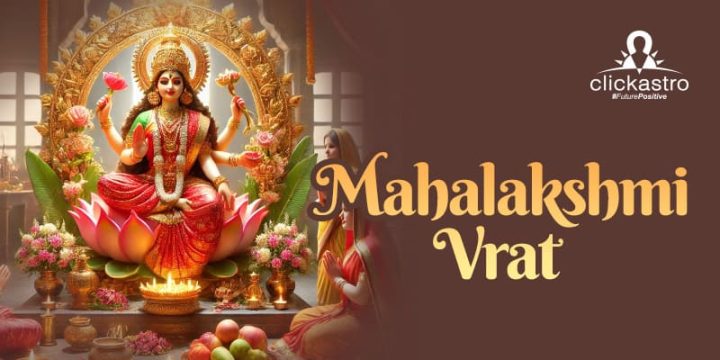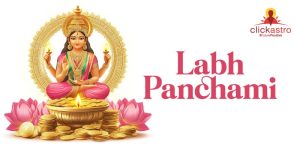Contents[hide]
The 2024 Mahalakshmi Vrat will commence on Wednesday, September 11.The vrat is believed to invoke the blessings of Goddess Lakshmi, thus ensuring happiness, peace, and prosperity for those who observe it with full faith and dedication. During this period, devotees engage in strict fasting, prayer, and various rituals, each symbolizing a deep connection to the goddess. The observance is more than just a ritual; it is a celebration of the divine feminine power, seeking the grace and favour of Goddess Lakshmi to fill one’s life and household with abundance and harmony.
Timing and Duration
Mahalakshmi Vrat begins on the ‘Ashtami’ (8th day) of the Shukla Paksha (the waxing phase of the moon) in the Hindu month of Bhadrapada, and concludes on the ‘Ashtami’ of the Krishna Paksha (the waning phase of the moon) in the month of Ashwin. According to the Gregorian calendar, this period generally falls in September-October. The fast begins four days after the auspicious Ganesh Chaturthi festival and continues through to the eighth day of the Pitru Paksha, a period dedicated to honouring ancestors.Important timings
- Sunrise – September 11, 6:16 AM
- Sunset – September 11, 6:30 PM
- Ashtami Tithi Timing – September 10, 11:12 PM – September 11, 11:47 PM
Rituals and Observances
The rituals and observances of Mahalakshmi Vrat are rich in symbolism and are carried out with deep devotion over 16 days. Each ritual is designed to honour Goddess Lakshmi and to invoke her blessings upon the devotees. These rituals are not only acts of worship but also represent the spiritual and cultural heritage of India, passed down through generations. Devotees meticulously follow a series of daily practices, from morning prayers to specific offerings, each with its significance. The following provides a detailed overview of these sacred rituals.Daily worship and fasting:
Daily worship and fasting during Mahalakshmi Vrat are central to the observance, reflecting the deep devotion of the devotees. Each day begins at sunrise, with devotees purifying themselves through a ritual bath, symbolizing the cleansing of both body and spirit. Following this, prayers are offered to Goddess Lakshmi, who is revered as the source of wealth, prosperity, and well-being. The idol of the goddess is adorned with flowers, incense, and other sacred items, all meticulously prepared to show devotion and reverence. Dhanteras: Worship of Lord Kuber and Goddess Lakshmi A unique aspect of the vrat is the tying of a special thread, known as a “Dora,” on the left hand of the observer. This thread, with sixteen knots, serves as a powerful symbol of the vow taken to complete the fast. Each knot represents a day of the fast, marking the continuous commitment to the vrat and the blessings sought from Goddess Lakshmi. The daily rituals, coupled with fasting, create a spiritual atmosphere that lasts during the entire period of the observance, fostering a deep connection with the divine.Honour eight forms of Goddess Mahalakshmi:
During Mahalakshmi Vrat, devotees honour all eight forms of Goddess Mahalakshmi, each representing a unique aspect of wealth and prosperity. These forms include Adi Lakshmi (the primal force), Dhana Lakshmi (goddess of material wealth), Dhanya Lakshmi (goddess of agricultural wealth), Gaja Lakshmi (goddess of power and strength), Santana Lakshmi (goddess of progeny), Veera Lakshmi (goddess of courage), Vidya Lakshmi (goddess of knowledge), and Vijaya Lakshmi (goddess of victory). By worshipping these eight manifestations, devotees seek holistic prosperity—encompassing spiritual, material, and familial well-being. Each form is revered with specific prayers and offerings, deepening the spiritual connection throughout the vrat.Worship to Surya Bhagwan:
In certain regions, as part of Mahalakshmi Vrat, devotees extend their worship to Surya Bhagwan, the Sun God, recognizing his vital role in sustaining life and health. Each morning, at sunrise, they offer ‘arghya,’ a ritual offering of water, to Surya Bhagwan. This act symbolizes gratitude for the life-giving energy of the sun and seeks his blessings for good health, vitality, and overall well-being. Offering arghya is a gesture of reverence to the Sun God, acknowledging his importance in the natural world and the spiritual world, ensuring a balanced and harmonious observance of the vrat.Sprinkling water with Durva grass:
As part of the daily rituals during Mahalakshmi Vrat, devotees perform the sacred act of sprinkling water with Durva grass after the puja. Sixteen blades of Durva grass, which are tender shoots with three blades each, are tied together, symbolizing purity and devotion. These tied grass blades are then dipped in water, and the sanctified water is gently sprinkled over the devotee’s body. This ritual is believed to have a purifying effect, cleansing both the body and soul of impurities. By performing this act, devotees prepare themselves spiritually to receive the divine blessings of Goddess Lakshmi, ensuring their minds and hearts are ready for the grace and prosperity she bestows.The recitation of the Mahalakshmi Vrat Katha:
This is a vital component of the daily rituals during the 16-day observance. This sacred narrative tells the story of the origins, significance, and divine power of the Mahalakshmi Vrat. By recounting the Katha each day, devotees immerse themselves in the spiritual essence of the vrat, reinforcing their faith and dedication to Goddess Lakshmi. The story serves as a reminder of the blessings that come from devotion and adherence to the vrat’s principles. Through the Katha, devotees connect with the divine, drawing inspiration and strength to fulfil their vows and receive the goddess’s grace.The final day:
The final day of Mahalakshmi Vrat, known as Udyapan, marks the successful completion of the 16-day fast and is celebrated with a special evening puja. This concluding ritual is filled with symbolic acts of devotion and thanksgiving to Goddess Lakshmi. Central to the Udyapan is the worship of the Purna Kumbha or Kalash, a sacred pot that embodies the essence of prosperity and abundance. The Kalash is carefully prepared by filling it with water, coins, and akshatas (unbroken rice), symbolizing purity, wealth, and the continuity of blessings. It is then adorned with mango or betel leaves, and a coconut is placed on top, further enhancing its sanctity. The Kalash is treated as a representation of Goddess Lakshmi herself and is worshipped with reverence. Devotees also prepare nine varieties of sweets and savoury dishes, which are offered to the goddess during the puja. These offerings are later distributed as prasad among family, friends, and neighbours, sharing the divine blessings of the vrat and celebrating the completion of this sacred observance with the community.Dietary restrictions:
During the 16 days of Mahalakshmi Vrat, devotees adhere to strict dietary restrictions as a form of spiritual discipline and devotion. The consumption of non-vegetarian food and alcohol is strictly prohibited, emphasizing the vrat’s focus on purity and self-restraint. This period of fasting is intended to cleanse both the body and mind, enabling devotees to deepen their connection with Goddess Lakshmi. By abstaining from indulgent foods and substances, devotees create a space for spiritual reflection, allowing them to concentrate fully on their prayers, rituals, and the divine blessings of the Goddess, thereby enhancing the sanctity of the vrat.Significance of Mahalakshmi Vrat
Mahalakshmi Vrat holds profound significance as it is celebrated to honour Goddess Lakshmi, who embodies Maa Shakti, the divine feminine power. This sacred observance is believed to bestow immense blessings upon devotees, including wealth, happiness, and prosperity, when performed with sincerity and devotion. The vrat’s importance is underscored in various scriptures, including the ‘Bhavishya Purana,’ which recounts how Lord Krishna advised Yudhisthira, the eldest of the Pandava brothers, to undertake the vrat to regain the wealth lost to the Kauravas during a game of dice. This recommendation illustrates the vrat’s power to restore fortune and well-being. Another well-known legend involves a poor devotee who, under Lord Vishnu’s guidance, observed Mahalakshmi Vrat to invite Goddess Lakshmi into his home. Through his dedicated practice, the devotee’s household was blessed with abundance and prosperity, highlighting the vrat’s efficacy in transforming one’s material and spiritual circumstances. This story has become a cornerstone of the vrat’s significance, reinforcing its role in attracting divine grace and prosperity. Mahalakshmi Vrat is also intertwined with other major observances, such as Radha Ashtami, Durga Ashtami, and Jyeshta Devi Puja, which occur during the vrat period. Radha Ashtami, marking the birthday of Goddess Radha, the beloved consort of Lord Krishna, is especially significant. It is celebrated on the same day as the start of the vrat and highlights the connection between divine love and devotion. The vrat thus not only honours Goddess Lakshmi but also aligns with broader spiritual practices and festivals, enriching the devotional experience and reinforcing the interconnectedness of Hindu ritualistic traditions.Mahalakshmi Vrat in 2024
In 2024, the Mahalakshmi Vrat will begin on September 11th and conclude on September 26th. Devotees across the country, particularly in the northern states, will engage in this sacred observance, seeking the blessings of Goddess Lakshmi for themselves and their families.As with all Hindu festivals and rituals, the essence of Mahalakshmi Vrat lies in the devotion and faith of the devotees. Whether observed for 16 days or just three, this vrat is a powerful spiritual practice that connects devotees to the divine energy of Goddess Lakshmi, ensuring her blessings of prosperity, peace, and happiness in their lives. May the observance of Mahalakshmi Vrat in 2024 bring you and your family the grace of Goddess Lakshmi and fill your home with wealth, joy, and tranquillity.








